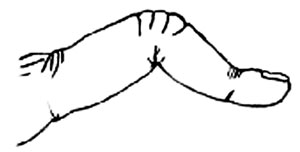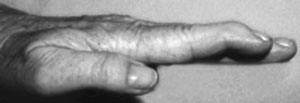This article comes in response to some recent medical problems with my right-hand little finger. I hope that my experience will reassure other flutists with similar difficulties that procedures can be devised to compensate for the situation.
My adventure began at 3:45 p.m. on Christmas Eve 2009 while I was visiting family in Florida. I had arrived at my seamstress’s home and was chatting with her while climbing the stairs to her studio. In my left arm I carried a box of shoes and a new formal gown that needed hemming. Suddenly I caught the tip of my shoe on the lip of the stair and pitched forward landing with all my weight on the small finger of my right hand. Aware that something was wrong but not wanting to alarm the seamstress, I brushed the fall off and continued up the stairs. While trying on the dress, I told my sister that I thought I had broken my finger.
When we finished, I went to an urgent care center because of the time of day, and sure enough the doctor pronounced I had broken the little finger of my right hand and added that I should see a specialist immediately after Christmas. He did not have a splint that would fit the tiny finger, so he suggested that I simply tape my finger to a popsicle stick broken to size.
It was at this point that it suddenly occurred to me that the little finger was the most important finger for a flutist; it is required for playing four keys and every note except middle and low D and high B. What a mess I was in!
After Christmas I dutifully made an appointment with the local hand surgeon but found that I would have to wait until December 31st to see the doctor. After several X-rays were taken the doctor said there was nothing she could do so she was sending me to a hand therapist to make a splint.
The hand therapist made the splint and gave me a home program of exercises. She said that, if I had further trouble, I should contact a therapist when I arrived home. I flew home the following day and within two weeks it was evident that there were serious problems. After contacting a friend for a recommendation for a hand surgeon, I found myself headed to Jackson, Mississippi to meet a new doctor.
Following a lengthy talk with the doctor and demonstrating what I needed to play the flute, he took several X-rays and told me that I had broken the proximal interphalangeal joint (PIPJ) and torn the central slip (tendon) away from the bone resulting in a totally bent PIPJ joint. As a result of the PIPJ problems, the ligaments on the sides of the finger had dropped out of place causing the tip of the finger to bend backwards at a 45-degree angle. This injury called a boutonniere deformity, is usually an athletic injury common in men.

There ensued much study and consultation on the part of the surgeon before he gave me my options. They were to continue therapy and hope that my range of motion would return; cut through the extensor tendon, which runs above the bone on the top of the finger, and wait to see how it healed; or have surgery to lengthen the extensor tendon by 2-4mm allowing the tip of the finger to relax and return to its normal position. I chose the third option because it was the only one that had some control over the outcome.
Almost immediately I began to deliberate on how and what I would still be able to play and practice. Afraid of loosing my embouchure, I decided that I could continue to work on breathing, long-tones, tone color changes, support, high-note endings and tapers, intonation, and articulations of all types.
I attempted several methods for stabilizing the end of the flute. Eventually I devised a sling for the foot joint using a small chain that I wrapped with a piece of soft fabric. Two S-hooks allowed this device to be hooked together and the extra length was to hang from another hook or a rod and be totally adjustable for proper playing height. Because the right-hand little finger is the stabilizer for the lower portion of the flute and would be useless because of splints, I needed to be able to brace the flute so I could use the other fingers as normally as possible.
The day after the surgery, with the finger bandaged and externally splinted, I began to develop a practice routine. For five weeks I practiced the items outlined above. During the fifth week I was allowed to take the splint off and practice regularly for half an hour per day. It quickly became evident, however, that now the fingertip was in the opposite position, which is called a mallet finger deformity.

The tip of the finger drooped at almost a 90-degree angle with no way to lift it. The tip was catching on the keys and there was no possible way to lengthen the finger to reach the roller keys on the foot joint.
Shortly after that discovery I went back for more surgery. This time the extensor tendon was shortened by 2mm and the finger was pinned (internally splinted) for five weeks. Now I was totally frustrated with having to return to the same old practice routine. I decided to try placing the right-hand ring finger on the D# key for stability, and by standing in front of a mirror, I could determine how to use the remaining two fingers over three keys. Practicing this way allowed me to play most scales – though slowly and awkwardly at first.
The amazing discovery for me occurred when the pin was removed and I was finally allowed to practice with no restrictions. I actually found myself going back to my nine-finger routine rather than using all 10 fingers.
I hope that my story will encourage others to seek solutions to similar physical challenges rather than giving up or putting the instrument away. Decide what aspects of flute playing you are able to work on and develop a plan that will make it happen. Do not be afraid to leave out a few notes you cannot play. Just keep the rhythm steady and play the notes you can with the best sound, intonation, tone color, etc. possible. You will be so glad you did when you can finally return to being a ten-fingered flutist!
Notes:
1 eMedicine online, s.v. “Orthopedic Surgery – Boutonniere deformity,” http://emedicine.medscape.com (accessed June 17, 2010).
2 eMedicine online, s.v. “Orthopedic Surgery – Mallet finger,” http://emedicine.medscape.com (accessed June 17, 2010).




